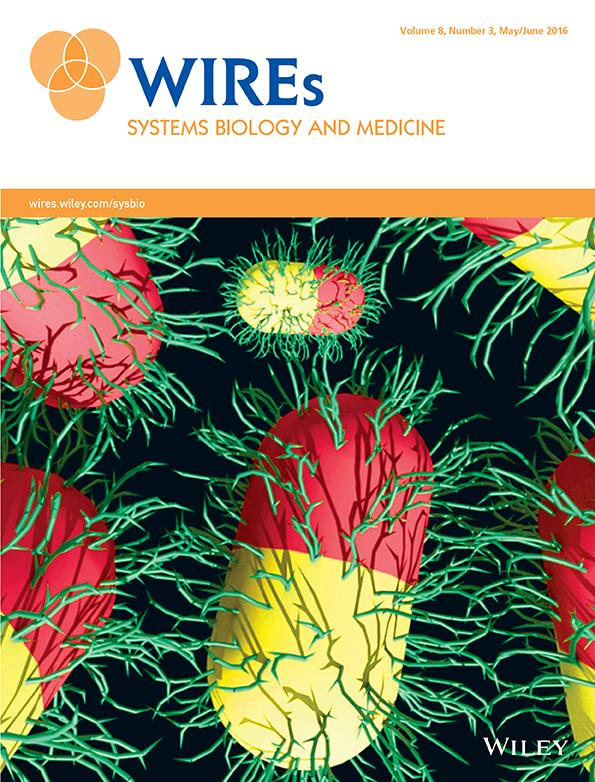基于稳定同位素的代谢组学和通量组学在蓝藻合成生物学中的应用
IF 7.9
Q1 Medicine
Wiley Interdisciplinary Reviews-Systems Biology and Medicine
Pub Date : 2019-12-09
DOI:10.1002/wsbm.1472
引用次数: 18
摘要
蓝藻的独特特性(如光合作用和固氮作用)使其成为生产生物燃料和其他增值生物化学品的潜在候选者。作为原核生物,它们可以很容易地利用合成生物学和系统生物学工具进行工程改造。蓝藻合成所需化合物的代谢工程需要深入了解中心碳和氮代谢,途径通量及其调节。代谢组学和通量组学通过直接表征细胞的生化活动,提供了对代谢的全面分析。这些信息是通过测量关键代谢物的丰度及其相互转化率获得的,这可以通过用稳定同位素标记细胞来实现,通过气相色谱/液相色谱-质谱GC/LC - MS或核磁共振(NMR)来量化代谢物池大小和同位素结合,以及数学建模来估计体内代谢通量。在这里,我们回顾了已经取得的进展,以适应代谢组学和通量组学工具来检查蓝藻模型物种。我们总结了代谢通量分析(MFA)策略的应用,以确定代谢瓶颈,可以有针对性地促进细胞生长,提高应激耐受性,或增强蓝藻的生化生产。尽管在过去的几年里,代谢组学、通量组学和其他合成和系统生物学工具取得了进展,但为了创造有效的光合宿主来生产增值化合物,还需要进一步努力来增加我们对蓝藻代谢的理解。本文章由计算机程序翻译,如有差异,请以英文原文为准。
Applications of stable isotope‐based metabolomics and fluxomics toward synthetic biology of cyanobacteria
Unique features of cyanobacteria (e.g., photosynthesis and nitrogen fixation) make them potential candidates for production of biofuels and other value‐added biochemicals. As prokaryotes, they can be readily engineered using synthetic and systems biology tools. Metabolic engineering of cyanobacteria for the synthesis of desired compounds requires in‐depth knowledge of central carbon and nitrogen metabolism, pathway fluxes, and their regulation. Metabolomics and fluxomics offer the comprehensive analysis of metabolism by directly characterizing the biochemical activities of cells. This information is acquired by measuring the abundance of key metabolites and their rates of interconversion, which can be achieved by labeling cells with stable isotopes, quantifying metabolite pool sizes and isotope incorporation by gas chromatography/liquid chromatography‐mass spectrometry GC/LC‐MS or nuclear magnetic resonance (NMR), and mathematical modeling to estimate in vivo metabolic fluxes. Herein, we review progress that has been made to adapt metabolomics and fluxomics tools to examine model cyanobacterial species. We summarize the application of metabolic flux analysis (MFA) strategies to identify metabolic bottlenecks that can be targeted to boost cell growth, improve stress tolerance, or enhance biochemical production in cyanobacteria. Despite the advances in metabolomics, fluxomics, and other synthetic and systems biology tools during the past years, further efforts are required to increase our understanding of cyanobacterial metabolism in order to create efficient photosynthetic hosts for the production of value‐added compounds.
求助全文
通过发布文献求助,成功后即可免费获取论文全文。
去求助
来源期刊

Wiley Interdisciplinary Reviews-Systems Biology and Medicine
MEDICINE, RESEARCH & EXPERIMENTAL-
CiteScore
18.40
自引率
0.00%
发文量
0
审稿时长
>12 weeks
期刊介绍:
Journal Name:Wiley Interdisciplinary Reviews-Systems Biology and Medicine
Focus:
Strong interdisciplinary focus
Serves as an encyclopedic reference for systems biology research
Conceptual Framework:
Systems biology asserts the study of organisms as hierarchical systems or networks
Individual biological components interact in complex ways within these systems
Article Coverage:
Discusses biology, methods, and models
Spans systems from a few molecules to whole species
Topical Coverage:
Developmental Biology
Physiology
Biological Mechanisms
Models of Systems, Properties, and Processes
Laboratory Methods and Technologies
Translational, Genomic, and Systems Medicine
 求助内容:
求助内容: 应助结果提醒方式:
应助结果提醒方式:


